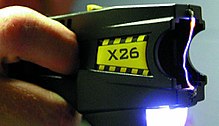Torture trade
The term torture trade refers to the manufacture, marketing, and export of tools commonly used for torture, like restraints and high-voltage electro-shock weapons. In 2001, Amnesty International released a report on "Stopping the Torture Trade".
Global manufacture
High-voltage electro-shock weapons were first developed in the US in the 1990s. They include electro-shock batons, stun guns, stun shields, dart-firing stun guns, and stun belts.
The biggest electro-shock manufacturers are located in the
The following table includes some of the countries identified by Amnesty International from 1998-2000 as engaged in the manufacture, distribution, supply, or brokerage of stun weapons and restraints.[1]
| Country 1998–2000 |
Number of manufacturers, distributors, suppliers, or brokers of stun weapons known to Amnesty International | Number of manufacturers, distributors, suppliers, or brokers of leg irons, shackles or thumbcuffs known to Amnesty International |
|---|---|---|
| Brazil | 3 | |
| China (PRC) | 9 | 1 |
| France | 6 | 1 |
| Germany | 11 | 3 |
| Israel | 6 | |
| Mexico | 2 | |
| Poland | 5 | |
| Russia | 3 | |
| South Korea | 8 | |
| South Africa | 7 | 2 |
| Taiwan (ROC) | 17 | 2 |
| United Kingdom | 2 | |
| USA | 42 | 22 |
Types of devices

One type of electro-shock weapon is the remote-controlled
Electo-shock weapons are one of the most common tools of torture. Electro-shock weapons are appealing because they leave no mark, although the physical and psychological effects are crippling. Shocks are often applied to sensitive areas like the soles of feet or genitals. Effects include severe pain, loss of muscle control, nausea, convulsions, fainting, and involuntary defecation and urination.[1] Internationally, electro-shock torture is used on children, pregnant women, and other vulnerable populations.
Opposition campaign
Regulations
In the European Union, Regulation No. 1236/2005, in effect since 2006, prohibits trade in goods which have no practical use other than torture, and requires licences for the export of goods which could have a use in torture as well as other legitimate uses.[3] Critics say the regulation contains too many loopholes to be effective.[4][5] Commission Implementing Regulation (EU) No 775/2014 lists prohibited and controlled goods. A proposal for amendments to Council Regulation (EC) No 1236/2005 was put forward by the European Commission on 14 January 2014 [6] and approved by the European Parliament on 30 June 2016.[7] The new regulation will ban the brokering of equipment which is subject to a ban and the supply of technical assistance regarding the supply of banned goods.
The US has also made regulatory changes to limit torture trade. The
Notes
- ^ According to Amnesty International, chemical spray was used in large quantities to quell a protest in Lusaka, Zambia in July 1997 and the 1999 WTO riots in Seattle. Amnesty International reported that it had been manufactured by the UK company Pains-Wessex. Subsequently, Amnesty called for an export ban when the receiving regime is either not fully trained in the use of chemical spray, or had shown usage "contrary to the manufacturer’s instructions".
References
- ^ a b c d e f g h i "Stopping the Torture Trade". Amnesty International. 2001.
- ^ "Continuing concerns about taser use". Amnesty International. 26 March 2006.
- ^ "Summaries of EU Legislation. Ban on trade in instruments of torture".
- ^ Wright, Steve (13 March 2003). "EU to Ban Torture Technology". The Guardian.
- ^ "Torture implements: MEPs call for review of EU legislation". European Parliament. 18 March 2010.
- ^ Proposal for a Regulation of the European Parliament and of the Council amending Council Regulation (EC) No 1236/2005 concerning trade in certain goods which could be used for capital punishment, torture or other cruel, inhuman or degrading treatment or punishment
- ^ Council of the EU, Torture Goods: Council confirms agreement with EP, 30 June 2016, accessed 7 October 2016
- ^ "Revisions to the Commerce Control List To Update and Clarify Crime Control License Requirements". United States Department of Commerce.
